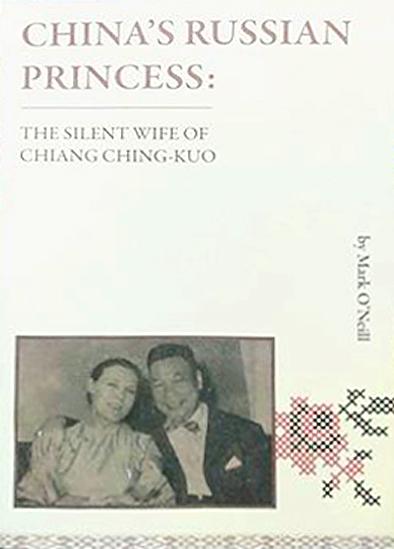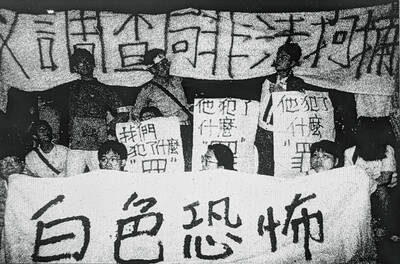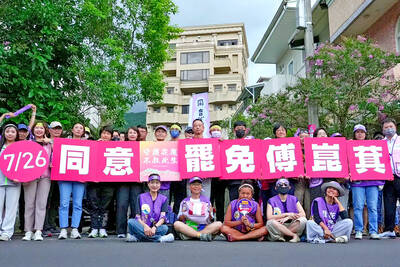“Though Chiang was born in Siberia, she displayed the virtues of a traditional Chinese woman,” said then-president Chen Shui-bian (陳水扁) following the death of Chiang Fang-liang (蔣方良) in 2004. “She was a good mother and a good wife who always put her family first.”
Leaving aside the Confucian morals, there are two striking features about Chen’s statement.
Firstly, Chiang Fang-liang was born about as far from Siberia as possible within the former Russian Empire. The only time she ventured east of the Ural mountains was on a train to Vladisvostok. From there, she proceeded by steamer to Shanghai, never to see Russia again. It was April 1937, a few weeks before her 21st birthday.

This leads to the second point: For the rest of her life, Chiang Fang-liang lived among Chinese and Taiwanese, almost exclusively speaking Mandarin with the thick Ningbo accent she acquired at Xikou (溪口), the ancestral home of Chiang Kai-shek (蔣介石). Having wed his son Chiang Ching-kuo (蔣經國), she was irrevocably committed. The Belarusian Faina Vakhreva had vanished, replaced by the Chinese Chiang Fang-liang.
But Chen could not quite bring himself to call her Chinese. Instead, she merely “displayed the virtues” of a Chinese woman.
That even Taiwan’s president was clueless about Faina’s background seems surprising. But as Mark O’Neill reveals in China’s Russian Princess: The Silent Wife of Chiang Ching-kuo, Faina was mysterious to all but her family and the select few with whom she associated.
In this first English-language account of Faina’s life, O’Neill, a Hong Kong-based writer, integrates primary sources — interviews with Faina’s daughter-in-law, the owners of Taipei’s “Russian” Cafe Astoria and her notorious youngest son, the late Alex Chiang (蔣孝武) — with Chinese-language biographies and memoirs.
More arbitrary are the conversations with everyday Taiwanese, which O’Neill relays without indicating why they offer insight.
“We know very little about her” says office worker Chang Mei-hwa (張美華) before adding, “She spoke very little — perhaps she was not allowed to speak. She was a simple housewife, with no involvement in politics.”
Taxi drivers are O’Neill’s go-to gauges of public opinion.
Cabbie Huang Li-kuo (黃立國) observes: “Faina has a good reputation among the public,” while fellow driver surnamed Wang says, “The media carried nothing about her. It was martial law. Who dared to ask such questions?”
Contradictions notwithstanding, given Faina’s nebulous existence, these asides are perhaps as illuminating as the biographical claims. In a society where truth was stage-managed and murky, perceptions were everything, the views of the masses represented an alternative reality. At any rate, the published material seems to have lead O’Neill astray.
A photo of a young Faina and Ching-kuo, crouching in the shallows of a body of water is described as having been taken in the mid-1930s at a river near Sverdlovsk (as the Russian city of Yekaterinburg was then known). In fact, it was the Black Sea resort of Sochi in 1935.
O’Neill is not the first person to err here. The best-known biography of Chiang Ching-kuo, The Generalissimo’s Son by Jay Taylor, puts the scene at Crimea. However, Uralmash, the factory in Yekaterinburg where Faina and Ching-kuo worked, has a copy of a postcard from the vacationers to their friends Fyodor Anikeyev and his wife Maria.
With “Sochi Riviera” scribbled in the margin, the note reads “Dear Fedya! We send you heartfelt greetings from Sochi. What’s new with you?” It is signed “Elizarov Kolya [Ching-kuo’s Russian name]” and “Fanya.”
On its own, this is not serious, but it bespeaks a wider problem: O’Neill neither visited Russia, nor contacted anyone there. Had he done so, he might have avoided a significant mistake in claiming Chiang Ching-kuo was under house arrest in 1937, his final year in Russia, after dismissal from his post as editor of the Uralmash newspaper.
“It’s not that simple,” says Sergey Ageyev, senior staff scientist at Uralmash. “Elizarov was defended by the head of the city organization of Communists [Mikhail] Kuznetsov. He was removed from the post of editor, but Kuznetsov immediately provided him with a job in the city council. As for house arrest, this could not be. At that time there was no such measure restricting freedom of persons under investigation. Detainees were held in prisons and shot there.”
While the narrative is generally engaging thanks to the strength of the story, stylistically, things get a little staid, with not much variation in pacing, tone or syntax. Several peculiarities mark the text, too, the use of quotation marks for the word “president” preceding references to Taiwan’s heads of state being notable. One wonders what influenced this decision by the Hong Kong publisher.
Where O’Neill succeeds is in communicating the poignancy of Faina’s lot. He depicts a woman with an “extrovert nature” gradually tamed as her limited pleasures are withdrawn. Games of mahjong are banned, a letter from her beloved sister destroyed, casual outings to markets and cinemas scaled back for security reasons. Gatherings at the Astoria are ruled out due to the cafe’s Russian associations. Gone is the woman who shocked Xikou’s residents by riding horses and donning a swimsuit to bathe in a creek while pregnant.
Her love for her husband permeates each chapter, and they maintained a taboo tactility throughout their half-century of marriage. Still, Faina sacrificed everything to become the dutiful Chinese wife, but — as the Chen quote indicates — was never fully understood or accepted. In the end, her remarkable life was reduced to what she was not. Says Lin Kuo-keung, another of O’Neill’s taxi drivers. “She stayed out of the limelight. She was foreign, not Chinese; she was a housewife, mother and wife.”
Yet, Faina compares favorably to Soong Mei-ling (宋美齡), her predecessor as first lady, who died a year earlier. “She lived simply and was not corrupt,” says cabbie Huang. “After [Chiang Ching-kuo] died, she stayed in Taiwan, which shows she had friends here. As soon as [Chiang Kai-shek] died, his wife went to live in the United States where she had a fortune. Faina did not do that.”

From the last quarter of 2001, research shows that real housing prices nearly tripled (before a 2012 law to enforce housing price registration, researchers tracked a few large real estate firms to estimate housing price behavior). Incomes have not kept pace, though this has not yet led to defaults. Instead, an increasing chunk of household income goes to mortgage payments. This suggests that even if incomes grow, the mortgage squeeze will still make voters feel like their paychecks won’t stretch to cover expenses. The housing price rises in the last two decades are now driving higher rents. The rental market

July 21 to July 27 If the “Taiwan Independence Association” (TIA) incident had happened four years earlier, it probably wouldn’t have caused much of an uproar. But the arrest of four young suspected independence activists in the early hours of May 9, 1991, sparked outrage, with many denouncing it as a return to the White Terror — a time when anyone could be detained for suspected seditious activity. Not only had martial law been lifted in 1987, just days earlier on May 1, the government had abolished the Temporary Provisions Effective During the Period of National Mobilization for Suppression of the Communist

Hualien lawmaker Fu Kun-chi (傅?萁) is the prime target of the recall campaigns. They want to bring him and everything he represents crashing down. This is an existential test for Fu and a critical symbolic test for the campaigners. It is also a crucial test for both the Chinese Nationalist Party (KMT) and a personal one for party Chairman Eric Chu (朱立倫). Why is Fu such a lightning rod? LOCAL LORD At the dawn of the 2020s, Fu, running as an independent candidate, beat incumbent Democratic Progressive Party (DPP) lawmaker Hsiao Bi-khim (蕭美琴) and a KMT candidate to return to the legislature representing

Fifty-five years ago, a .25-caliber Beretta fired in the revolving door of New York’s Plaza Hotel set Taiwan on an unexpected path to democracy. As Chinese military incursions intensify today, a new documentary, When the Spring Rain Falls (春雨424), revisits that 1970 assassination attempt on then-vice premier Chiang Ching-kuo (蔣經國). Director Sylvia Feng (馮賢賢) raises the question Taiwan faces under existential threat: “How do we safeguard our fragile democracy and precious freedom?” ASSASSINATION After its retreat to Taiwan in 1949, the Chinese Nationalist Party (KMT) regime under Chiang Kai-shek (蔣介石) imposed a ruthless military rule, crushing democratic aspirations and kidnapping dissidents from